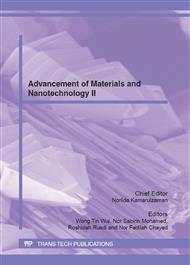p.235
p.240
p.247
p.251
p.259
p.264
p.269
p.275
p.279
Ionic Transport in PMMA-NaCF3SO3 Gel Polymer Electrolyte
Abstract:
In this work, the polymethylmethacrylate (PMMA) based gel polymer electrolyte samples have been prepared by the solution casting technique. The composition range of the salt was from 3 wt% to 35 wt%. The ionic conductivity of the samples was measured using a.c. impedance technique. The highest room temperature conductivity was obtained from the sample containing 30 wt% of NaCF3SO3 salt, i.e. 5.31 x 10-3 S cm-1. The increase in the ionic conductivity with increasing salt concentrations is due to the increase in both concentration and mobility of charge carriers. The decrease in ionic conductivity at higher salt concentrations can be explained by aggregation of the ions, leading to the formation of ion-pair, thus decreasing the number of charge carriers and hence the ionic mobility. The conductivity-temperature dependence obeys the Arrhenius rule from which the activation energy was evaluated. The ionic transference number estimated by dc polarization method revealed that the conducting species are predominantly ions.
Info:
Periodical:
Pages:
259-263
Citation:
Online since:
July 2012
Price:
Сopyright:
© 2012 Trans Tech Publications Ltd. All Rights Reserved
Share:
Citation:


